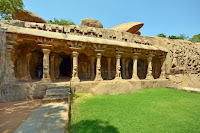THE PANCHAPANDAVA CAVE TEMPLE
Near the village Vilapakkam (about 6 km from Arcot town) rises a chain of imposing granite hills of which the western part is called Chinna Tiruppamalai and the eastern Perya Tiruppamalai. A natural cave on top of the Chinna Tiruppamalai houses the tomb of a Muslim saint and the whole area with a small mosque nearby is a frequented place of pilgrimage for Mohammedans.
From the Periya Tiruppamalai on the eastern side of the hills, a large cave temple with seven shrine niches was excavated, which, according to the inscriptions in it (one by Nandivarman and the other by the Chola king Rajaraja I), had the name of the hill-Periya Tiruppamalai.
At present, the temple is popularly known as Panchapandavamalai cave temple. According to K. R. Srinivasan the excavation can be ascribed to King Mahendravarman I; it was probably commenced towards the end of his reign and dedicated to Siva and other gods. The picturesque hills formed by huge boulders strongly remind one of the stony wilderness of Dalavanur. The cave temple which was excavated from an enormous single rock could not stand the weight of the hill above.
Its heavy, almost unshaped pillars, (six forming the fa-cade and six in the interior) cracked during the excavation work which was consequently abandoned. Its un-even floor slopes from the hind wall to the front. Seven shallow shrine niches were carved from the back-wall of the ardha mandapa and are, as the rest of the excava-tion, only roughly formed. A ledge overhanging the facade serves as a cornice; above it a drip line for the rain water was cut into the rock.
A shallow niche above this drip line contains an image of a Jain tirthankar which would confirm the assumption that in subsequent centuries the cave temple was occupied by the Jainas.
From the Periya Tiruppamalai on the eastern side of the hills, a large cave temple with seven shrine niches was excavated, which, according to the inscriptions in it (one by Nandivarman and the other by the Chola king Rajaraja I), had the name of the hill-Periya Tiruppamalai.
At present, the temple is popularly known as Panchapandavamalai cave temple. According to K. R. Srinivasan the excavation can be ascribed to King Mahendravarman I; it was probably commenced towards the end of his reign and dedicated to Siva and other gods. The picturesque hills formed by huge boulders strongly remind one of the stony wilderness of Dalavanur. The cave temple which was excavated from an enormous single rock could not stand the weight of the hill above.
Its heavy, almost unshaped pillars, (six forming the fa-cade and six in the interior) cracked during the excavation work which was consequently abandoned. Its un-even floor slopes from the hind wall to the front. Seven shallow shrine niches were carved from the back-wall of the ardha mandapa and are, as the rest of the excava-tion, only roughly formed. A ledge overhanging the facade serves as a cornice; above it a drip line for the rain water was cut into the rock.
A shallow niche above this drip line contains an image of a Jain tirthankar which would confirm the assumption that in subsequent centuries the cave temple was occupied by the Jainas.






Comments
Post a Comment